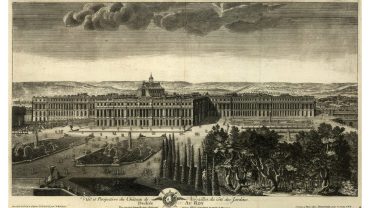Believed to prowl the graveyards, execution sites, forests, old trackways and lakes around the coastline and countryside of East Anglia, Black Shuck – known sometimes as Old Shuck or Old Shock – is a legendary English ghost dog, and, some say, a sinister portent of death. Legend tells that those who encounter Black Shuck may be marked for doom, with tragedy soon to follow. This eerie figure has become one of England’s most famous and enduring supernatural tales.
Others say the dog is benevolent, even companionable, helping people out of tight spots and protecting them from harm.
But is Black Shuck real or are we barking up the wrong tree? This time trip back as far as the twelfth century will attempt to shed light on the story of spectacularly spooky spectral black dogs.
What are Spectral Black Dogs?

Is the legend real...? (Credit: David Wall via Getty Images)
The legend of ghost dogs isn’t unique to East Anglia, indeed alleged sightings have been recorded all over the UK, often linked to the supernatural, associated with both protective and malevolent forces. Some paranormal investigators, folklorists, and psychologists believe these stories may have their origins in Celtic, Germanic, or Norse folklore, blending pagan beliefs in animal spirits with later Christian interpretations of good and evil.
While there are lots of different reports of ghost dogs spanning hundreds of years, they all appear to take on similar characteristics. Each one is described as being black with shaggy hair, varying in size from a big dog to that of a horse or cow, and having either two glowing red eyes, or in some cases, a single, cyclops-type eye.
The Emergence of Old Shuck

Peterborough Cathedral, formerly Peterborough Abbey (Credit: Travelpix Ltd via Getty Images)
Perhaps from the Old English scucca, meaning ‘devil’ or ‘fiend’, which might have come from the root skuh, meaning ‘to frighten’, the first printed use of the words Black Shuck comes from 1850 in Notes and Queries, a journal of short articles relating to the history and lexicography of English language and literature. Reverend ES Taylor wrote of ‘Shuck the Dog-fiend’ –
This phantom I have heard many persons in East Norfolk, and even Cambridgeshire, describe as having seen as a black shaggy dog, with fiery eyes and of immense size, and who visits churchyards at midnight.
While this was the first time the words Black Shuck appeared in print, earlier mentions of black dog legends exist, perhaps as early as the twelfth century.
The Peterborough Chronicle
While it’s not certain, perhaps the earliest documented mention of a spectral black dog is from a version of the Anglo-Saxon Chronicle maintained by the monks of Peterborough Abbey around 1127. It doesn’t specifically mention Black Shuck or Old Shuck, but describes a ghostly black dog-like figure seen in the area around Peterborough following the arrival of a new abbot. While this account is not directly tied to Black Shuck, it’s considered an early example of ghost dog sightings in English folklore.
The specific East Anglian legend of Black Shuck gained prominence later, with the infamous 1577 reports from Bungay and Blythburgh. These stories are based on oral traditions and a few written accounts whose accuracy has been long debated, and what truth or superstition may be behind it has been largely lost to the mists of history.
Sunday, 4th August 1577: Bungay, Suffolk

The altar in St Mary's Church in Bungay, Suffolk (Credit: whitemay via Getty Images)
During a violent thunderstorm, parishioners were gathered for a service at St. Mary’s Church in Bungay, Suffolk, when this famous English ghost dog allegedly burst into the church. Witnesses reported seeing the large, fearsome creature moving through the congregation with incredible speed, its eyes glowing with fire.
According to local accounts, the dog attacked several people, killing two and injuring others. These events, compounded by the violent storm and the panic it caused, added to Black Shuck’s reputation as a harbinger of death and destruction. Yet the chaos of these events wasn’t over, and later that same day Black Shuck is said to have reappeared.
Sunday, 4th August 1577: Blythburgh, Suffolk

The Holy Trinity Church in Blythburgh, Suffolk (Credit: Rob Atherton via Getty Images)
About thirteen miles south of Bungay, in the town of Blythburgh, the most famous of all spectral black dogs struck again. During the Sunday service at Holy Trinity Church witnesses reported that a monstrous black dog, later said to be Black Shuck, crashed through the mighty oak doors of the church. According to the legend, the creature with fire-red eyes ran through the congregation, causing pandemonium and panic. Amid the chaos, so the story goes, the church steeple collapsed through the roof.
In the recounting of this terrifying encounter, the beast allegedly killed two people – supposedly a man and a boy – and severely injured another with either its teeth or claws. As Black Shuck fled the church, it’s said to have left deep scorch marks, often referred to as ‘the devil’s fingerprints,’ on the door which remain there to this day.
Later Sightings

Did local fishermen see Black Shuck at Blakeney Point? (Credit: Gary Yeowell via Getty Images)
In the following 450 years, there have been many reported sightings of what may be Black Shuck, but unfortunately, there’s no hard evidence to suggest any of them are real.
During the nineteenth century, there were dozens of stories told by locals, particularly in and around Norfolk, of encounters with a large, black dog on desolate roads and footpaths, especially near graveyards and churches. In many cases, the beast would vanish without a sound, leaving witnesses shaken but unharmed. These sightings helped reinforce the association between Black Shuck and death or misfortune, with some witnesses reportedly experiencing personal tragedy soon after their encounter.
In 1912 in the coastal town of Overstrand, a local man said he saw a large black dog near the cliffs. He claimed the creature appeared suddenly, with eyes that glowed like coals, before vanishing into thin air. A short distance up the coast at Blakeney Point, a group of fishermen in the 1920s claimed to have seen a large black dog walking along the beach before it disappeared into the mist.
One of the most terrifying reported encounters with Old Shuck is from a young girl during World War II who claimed a black dog with red eyes came in through her window, walked around her bed, stared at her for a few seconds and then promptly disappeared.
In the 1970s, in the town of Aylmerton a few short miles inland from Overstrand, a driver travelling through the countryside claimed to have seen a large black dog with glowing red eyes on the roadside. The driver slowed down, but as they approached, the dog vanished.
What is Black Shuck?

Is mist to blame for the legend of Black Shuck? (Credit: Cavan Images via Getty Images)
The legend of this spooky English ghost dog, like many other supernatural stories, has sparked numerous theories attempting to explain its origins and meaning. From folklore and mythology to more natural or psychological interpretations, here are some of the prevailing theories behind the Black Shuck legend:
Pagan Mythology & Pre-Christian Beliefs
Black Shuck may originate from ancient Celtic, Germanic and Norse beliefs, where black dogs were guardians of the dead or linked to the underworld. These associations with death and spirits were likely incorporated into local Christian folklore, casting the creature in a more sinister, devilish role, particularly near churches and graveyards, and later around execution sites.
Weather or Natural Phenomena
Some suggest Black Shuck is linked to natural events like thunderstorms or coastal fog, which could create eerie conditions and lead to strange sightings. Storms, lightning, and mist may have been interpreted as supernatural forces, with the dog representing these terrifying natural occurrences or as an optical illusion in misty or dark environments. Some more extreme psychological or physiological explanations are known as hypnagogic hallucinations or pareidolia, where the brain sees familiar shapes in darkness or mist.
Omen Lore
In the European versions of the tales, spectral black dogs are usually seen as bringers of impending doom and the specific story of Black Shuck, particularly in the sixteenth century, may have reflected such fears of death, illness, anxiety, or disaster.
Feral Dogs or Large Animals
Some suggest Black Shuck sightings may be based on real encounters with large, feral dogs or animals. These creatures, particularly in rural areas, could have inspired fear, with folklore exaggerating their size and behaviour. Over time, sightings of such large dogs might have evolved into the supernatural Black Shuck legend.
Other Encounters with ‘Ghost Dogs’

Did Black Shuck roam the corridors of Newgate Prison? (Credit: ilbusca via Getty Images)
There are many legends of similar ghost dogs or hellhounds found in myths and legends from folklore. In the UK, some of the most infamous examples of regional spectral black dogs include:
Padfoot
Said to roam across West Yorkshire, legend has it that Padfoot is heard trailing a heavy chain, flitting in and out of sight and uttering a guttural roar unlike any other animal.
Barghest
Preying on people in the narrow alleyways of ancient York, Barghest (sometimes Barguest) is reputed to be an omen of imminent doom.
The Black Dog of Newgate
Demolished in 1904, Newgate Prison was used for over 700 years and was said to be haunted by a ghost dog. It was said that when prisoners were convicted of murder and condemned, the spectre of a black dog would roam the prison, perhaps in the form of the ghosts of victims avenging their murderers.
Gurt Dog
In the interests of balance, Gurt Dog (or Great Dog) would roam the Quantock Hills in Somerset and would look after children playing unsupervised, their parents believing the dog would protect them. It is also said to have guided lost travellers back to safety.
There are dozens of stories of spectral black dogs from all over the UK and Europe, but perhaps the most well-known remains Black Shuck.
The Legacy of the Legendary English Ghost Dog

The legend of Black Shuck remains...(Credit: David Wall via Getty Images)
Go into any pub in rural Norfolk and you may find someone who claims a connection to Black Shuck. A neighbour, a relative, or someone who knows someone who has a story about a run-in with Black Shuck.
Over the centuries, the stories have become somewhat fluid, with elements added and embellished for poetic licence, but the persistence of the stories, from ancient rural legends to more recent sightings, shows how deeply rooted this ghost dog remains in English cultural memory.
Whether as a terrifying omen or a relic of older mythologies, Black Shuck continues to loom large in the imaginations of those who live in its shadow.












